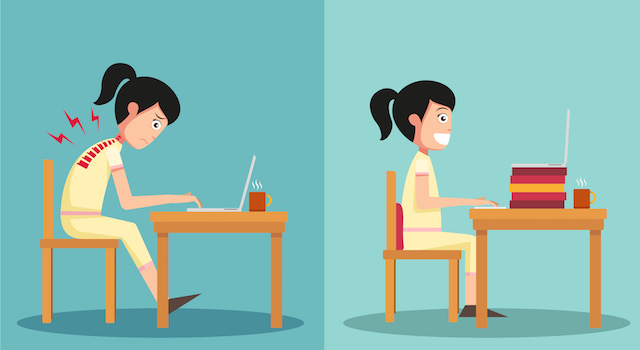
We all know that good posture is desirable, from not only an aesthetic point of view – who doesn’t like the compliment, “Look at what nice posture you have!”- but from a physiological point of view as well. Good posture allows the bones to align resulting in the architecture of the body supporting our constant need to resist that ever present force of gravity, which in turn, allows the muscles, both deep/core, and superficial, to fire more effectively to move the skeleton with less stress. For many of us, our good posture is thwarted by habits that have developed as a result of sitting for long stretches at a time. Sitting is often a daily reality whether it is part of having to be at a computer for work, constantly driving for a long commute, or running kids around to get them where they need to be, at the end of the day, if we tally up how long we actually find ourselves in a sitting position, the minutes add up to hours very quickly. When we compare this to the amount of time we spend in the Pilates studio, or involved in exercise of any kind, it becomes clear that the scale is tipped toward that stagnant sitting position. If we take it a step further and analyze how we sit (for many this includes a posteriorly tilted pelvis, rounded back and shoulders, and head jutting forward from our cervical spine) we begin to pull apart how detrimental this poor posture can be, which also translates to our standing posture and how we organize our movement through space.
So what can we do? Standing desks are becoming more and more popular, but are not yet practical, and simply bringing poor sitting posture into standing won’t address the muscle groups that need to be balanced in order to do either properly. Becoming more aware of our posture is the first step – understanding how the sitting bones provide immediate feedback regarding pelvic alignment and then working to balance the torso/hip flexors and extensors, freeing the ribcage and balancing the muscles around the shoulder girdle can begin to unwind the patterns that support poor posture, all of which are addressed in the studio in most every session or class. But the key is taking that information and applying it to our everyday lives, creating an environment where the body can take what it experiences in the studio and use that information to help us move, and sit, more functionally in our daily activities.
The next time you find yourself in a sitting position for an extended period, take a moment to find that neutral alignment of the pelvis – then close your eyes and breathe deeply, expanding through the torso and ribs while imagining a string gently lengthening the spine providing a subtle ‘re-set’ of the postural muscles. Getting up and moving around periodically (at least once every hour) can also break the stagnation that develops when we stay locked in one position for an extended time, and then, of course, coming into the studio to hone those skills of listening to the body and unlocking those areas that have become resistant through focused, integrated movement can provide the extra feedback the body needs to be able to organize itself in more holistic ways.
We hope to see you soon!
Click HERE to schedule with this instructor.
Click HERE to take classes with this instructor.
